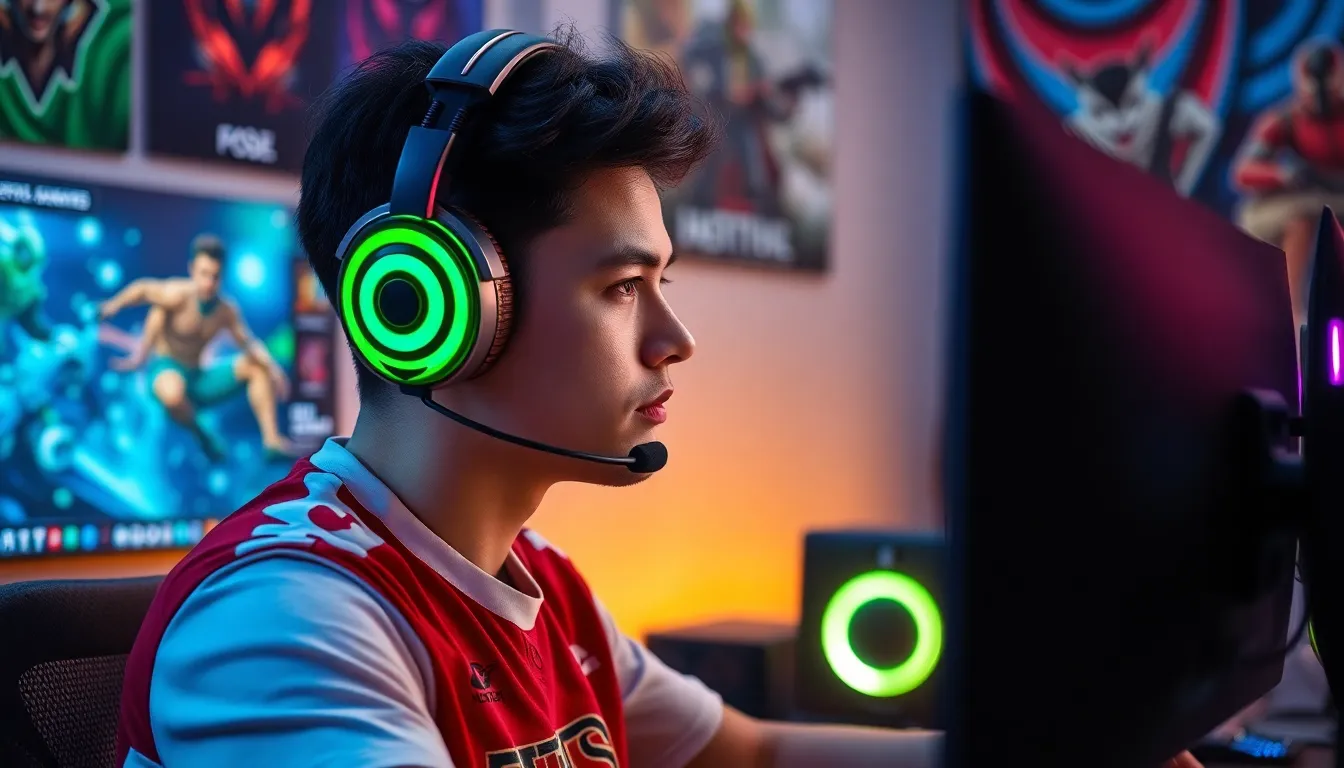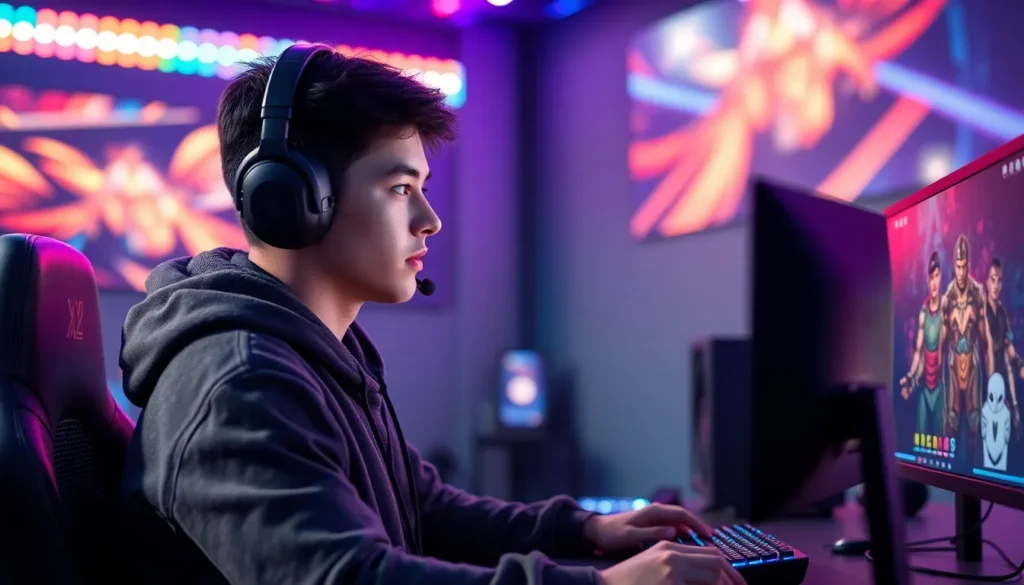Table of Contents
ToggleEsports has exploded into a global phenomenon, captivating millions of fans and players alike. Social media plays a pivotal role in this vibrant community, shaping how gamers connect, share, and engage with one another. From Twitter updates to Instagram highlights, platforms are essential for building relationships and fostering a sense of belonging among fans.
As the esports landscape evolves, so does the way content creators and teams leverage social media to promote their brands and reach wider audiences. With real-time interactions and instant feedback, these platforms offer unique opportunities for engagement that traditional sports can only dream of. Understanding the dynamics of esports social media is crucial for anyone looking to navigate this exciting and rapidly changing environment.
Overview of Esports Social Media
Esports social media plays a crucial role in the ecosystem of competitive gaming. Platforms like Twitter, Instagram, Facebook, and Twitch facilitate communication and interaction among fans, players, and organizations. These platforms enable real-time updates, allowing fans to follow live events, player performances, and team announcements instantly.
Engagement and Community Building
Engagement on social media fosters a sense of community. Users share content, participate in discussions, and interact directly with their favorite players and teams. Hashtags like #Esports and #GamingCommunity help connect users to broader conversations, enhancing visibility and engagement.
Branding and Promotion
Social media serves as an effective branding tool for teams and content creators. Teams use these platforms to showcase achievements, launch merchandise, or announce sponsorships, which helps in establishing their identities. Content creators, including streamers and influencers, leverage social media to build personal brands and attract sponsorships as well.
Content Variety
The content shared on esports social media varies significantly. Clips from matches, behind-the-scenes footage, memes, and fan art create a diverse media landscape. This variety not only entertains but also promotes engagement by encouraging fans to participate in creating their own content.
Live Interaction and Streaming
Live streaming integrates seamlessly with social media. Platforms like Twitch, YouTube, and Facebook Gaming allow players to broadcast gameplay while interacting with viewers through chat. This real-time interaction strengthens relationships between content creators and fans, fostering loyalty and community spirit.
Analytics and Insights
Esports organizations utilize data analytics from social media engagement to refine strategies. Insights into fan behavior, preferences, and demographics allow for targeted content delivery. This data-driven approach enhances marketing effectiveness and fosters deeper connections with the audience.
Future Trends
The future of esports social media remains promising. Innovations such as augmented reality (AR) experiences and interactive content formats are emerging. These advancements will likely shape how fans consume and interact with esports, further integrating social media into the fabric of competitive gaming.
The Growth of Esports Social Media

Esports social media experiences exponential growth, reflecting the competitive gaming industry’s expansion. It serves as a dynamic hub connecting fans, players, and organizations with unique engagement opportunities.
Key Statistics and Trends
| Statistic | Value |
|---|---|
| Global esports audience | 474 million |
| Projected revenue by 2024 | $1.6 billion |
| Increase in esports influencer partnerships | 25% annually |
| Engagement rate on Twitter for esports posts | 25% higher |
Esports attracts millions of followers across various demographics. A projected increase in revenue reflects growing investments from brands and advertisers. Recent trends indicate esports influencers’ partnerships rise significantly, enhancing visibility. Engagement rates on Twitter for esports posts surpass traditional sports, confirming fans’ active participation.
Major Platforms for Esports Engagement
- Twitter: Facilitates real-time updates, interactions, and community discussions through trending hashtags like #Esports and #Gaming.
- Instagram: Features visual storytelling that showcases player highlights, team moments, and fan art, promoting community bonding.
- Twitch: Dominates live streaming, allowing fans to watch gameplay while engaging directly with streamers through chat and donations, enhancing loyalty.
- YouTube: Serves as a repository for match highlights, tutorials, and esports documentaries, fostering connections among viewers and content creators.
- TikTok: Captivates younger audiences with short-form content, featuring gameplay snippets and humorous takes, driving viral engagement.
Each platform offers distinct advantages for teams and content creators, allowing tailored strategies that maximize audience reach and interaction within the esports community.
Impact on Esports Communities
Esports social media significantly shapes the dynamics of gaming communities, promoting strong connections among fans, players, and organizations. This impact is evident in various ways.
Building Relationships Among Fans
Building relationships among fans occurs through active engagement on social media platforms. Fans connect over shared interests, rally around teams, and participate in discussions using hashtags like #EsportsCommunity and #Gaming. Platforms such as Twitter and Discord facilitate real-time interactions, allowing fans to share experiences, predictions, and insights about tournaments. Esports teams often encourage fan involvement by creating exclusive content, such as polls and contests, which further fosters a sense of belonging. This engagement enhances loyalty and creates vibrant fan cultures around specific games and teams.
Fostering Player and Organization Interaction
Fostering player and organization interaction happens through transparent communication channels provided by social media. Players utilize platforms like Twitch and Instagram to connect with their audiences, sharing personal experiences and insights into their training and lifestyles. Organizations leverage this direct line to fans by posting updates on team news, match performances, and player achievements. This transparency not only humanizes players but also strengthens the bond between fans and teams. Social media serves as a space for organizations to gather feedback and adapt strategies, ensuring they meet fan expectations and preferences effectively.
Marketing and Sponsorship Opportunities
Esports social media presents numerous marketing and sponsorship opportunities for brands to engage with audiences. Through innovative strategies, companies can leverage the unique aspects of the esports ecosystem to build strong connections with fans.
Brand Engagement Strategies
- Influencer Partnerships: Engaging with influential gamers and content creators helps brands reach niche audiences. Aligning products with popular figures in esports enhances credibility and encourages fan loyalty.
- Interactive Campaigns: Brands utilize polls, contests, and interactive content to boost engagement. Campaigns that involve fans directly foster a deeper connection, encouraging sharing and participation.
- Real-time Content Creation: Brands create timely content that resonates during live events. Using live updates, highlights, and commentary allows companies to capitalize on high engagement moments.
- Community-focused Initiatives: Supporting community-driven events and tournaments builds goodwill. Brands that invest in grassroots gaming cultures gain respect and trust from targeted audiences.
- Cross-platform Promotion: Implementing campaigns across multiple platforms maximizes reach. Coordinated efforts on Twitter, Instagram, and Twitch ensure diverse audience engagement.
Case Studies of Successful Campaigns
| Brand | Campaign Description | Results |
|---|---|---|
| Red Bull | Sponsored a series of esports tournaments, integrating customizable content for fans during live streams. | Increased brand mentions by 40%. |
| Riot Games | Launched a “#LeagueofLegends Challenge” on social media, encouraging user-generated content from fans. | Accumulated over 1 million participations. |
| Intel | Collaborated with streamers for “Intel Gaming Nights,” showcasing gaming performance while promoting hardware. | Boosted hardware sales by 30%. |
| Monster Energy | Partnered with esports teams for unique branding opportunities in team merchandise and content. | Enhanced brand loyalty among esports fans. |
| Coca-Cola | Developed limited-edition cans featuring popular esports teams, integrating QR codes for fan interaction. | Increased product sales by 20% in targeted regions. |
Successful campaigns demonstrate the potential of leveraging social media effectively. Integrating engaging content, community involvement, and meaningful partnerships drives brand performance in the competitive esports landscape.
The Future of Esports Social Media
The landscape of esports social media continues to evolve, driven by technological advancements and changing audience preferences. Predictions indicate significant shifts in how fans engage with content in the coming years.
Predictions and Innovations
Innovations such as augmented reality (AR) and virtual reality (VR) are set to transform fan experiences. These technologies allow fans to immerse themselves in live events, creating interactive viewing experiences that enhance connection.
Platforms may increasingly adopt AI-driven analytics, optimizing content delivery based on real-time audience behavior. Enhanced personalization strategies will likely tailor content to individual preferences, strengthening engagement.
Emerging content formats, including short-form videos and interactive live streams, will become prominent. TikTok, for example, is already becoming a favorite among younger fans, influencing how esports highlights are shared.
Additionally, blockchain technology could revolutionize fan engagement through unique digital collectibles, enhancing loyalty programs. Fans might soon own verified in-game items, showcasing their support for specific teams or players.
Furthermore, growth in mobile gaming will drive esports social media engagement on handheld devices. Social platforms optimizing their interfaces for mobile use will facilitate seamless interactions among fans, content creators, and teams.
Brands will also innovate their marketing strategies, leveraging real-time engagement to connect with audiences. Creative campaigns incorporating gamified experiences will encourage fan participation, building community around brands and games.
Overall, these predictions point toward a more interactive, connected, and personalized future for esports social media.
Esports social media is reshaping how fans and players interact within the gaming community. Its ability to foster connections and engagement creates a vibrant ecosystem that thrives on real-time communication. As platforms evolve and new technologies emerge, the potential for deeper fan involvement and innovative content delivery is immense.
The future promises exciting advancements that will enhance the esports experience for both fans and players. With the rise of interactive formats and personalized content, stakeholders must stay ahead of the curve. Embracing these changes will be crucial for maintaining relevance in a rapidly growing industry where community and engagement are key.







